Scalaria koi: description and content
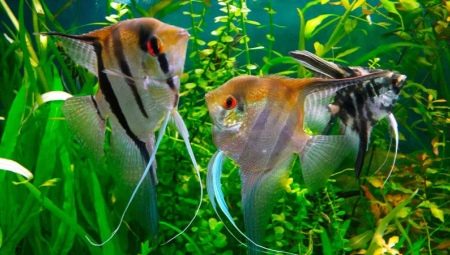
Fish farming is a sweet experience. Unlike animals, such as cats and dogs, which require special care, aquatic life benefits from silence. They are unpretentious and graceful, calm the nerves and create an atmosphere of comfort. An aquarium can replace a night light. The light passing through the water does not hit the eyes and at the same time, the bedroom is slightly illuminated. But who can be placed in a cozy aquarium so that these inhabitants are pleasing to the eye? These can be scalars.
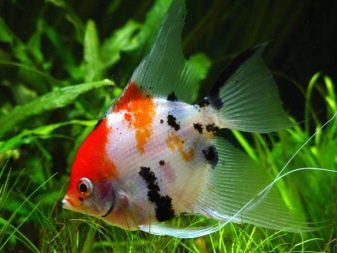
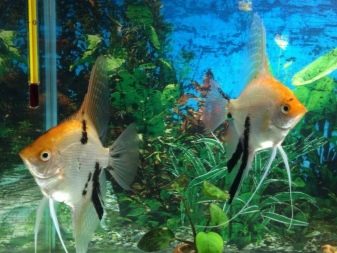
What is it?
There are aquarium fish that "hang" in the water. Fins like wings are visible through their transparent glass. It is not hard to guess that we are talking about koi scalars (scientifically Pterophyllum scalare, perches (Perciformes) - order, and the cichlid family, cichlids (Cichlidae)). These aquatic inhabitants received the Latin name from the generally recognized zoologist from Austria I. Ya. Heckel in 1840.
If we talk about the exact translation, then pteron is a feather, phyllon is a leaf, and, connecting the bases, you get a “winged leaf”. However, Martin G. Karl Lichtenstein gave the fish its name Zeus scalaris in 1823. Other lovers of these fish have also been noted in history. Baron Georges L. Frederic Bagubert Cuvier, who in 1931, after studying this specimen, nicknamed the scalar Platax scalaris. And since members of such a well-known fish family had great success with consumers, they were even given the marketing nickname Blattfische (leaf fish).
If we talk about the description, then we can say except for a narrow thin body, the scalar is endowed with oblong anal and dorsal fins. This gives it the appearance of a crescent moon. Natural color is silver with black lines.They can grow to a height of about 24 cm or more, and in length they grow up to 15-16 cm. The fish look quite elegant because of their sailing fins. An unusual body shape gives them the appearance of an angel; it is not for nothing that aquarists have been breeding them for more than a hundred years.
Pisces-angels are not capricious in content, in food and have a rather primitive intellect.
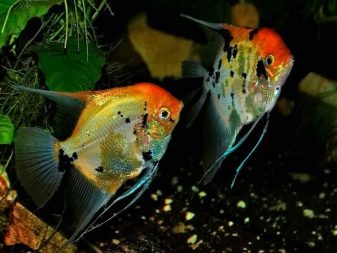
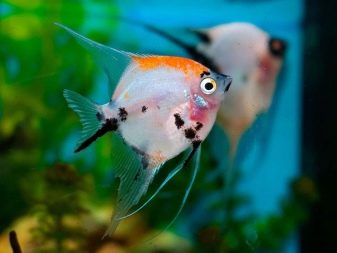
Live scalars were first brought to Europe (according to some unverified data) in 1911. Prior to this, attempts were also made, but very unsuccessfully. In 1909, the fish were taken to their destination, but dead. Aquarists have been working all the time on the problem of reproduction of scalars. In 1914 I. Kvankaru made the first reproduction. All technologies were not strictly disclosed, but there was a leak, and since 1920, angelfish began to multiply in huge volumes. In Russia, the secret of scalar brood was also revealed, but this happened in 1928.
Lovers of beautiful fish did not stop there and began to work on improving the species. Breeding activity was carried out in all directions. This is how specimens appeared that had a very beautiful color. American C. Ash gave birth to a marble scalar. At this time, there are a great many colors and shapes of these fish. Here are some of them: diamond, scaleless, semi-black, cobra, leopard, red-smoky, pearl, gold-pearl, red-pearl, marble-red-gold, smoky, albino, red, chocolate, there is even a phantom , two-spotted and also under the phantom, indigo shade, lace zebra, zebra-like, red-half-black, white.
It should be remembered that scalars live and reproduce in natural conditions... In South America (in its northern part), they are found in water bodies where there is dense reed or other thickets. The water should be standing or flowing slowly. This is why scalars actually have a washer-like body. It is needed for maneuvering among reed thickets. Cichlids are schooling fish, the school consists of about ten individuals.
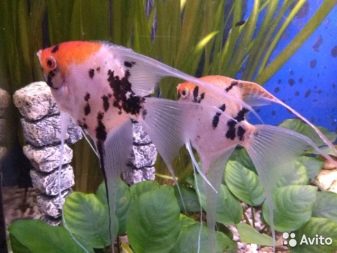

Care and compatibility with different fish
You need to start with the parameters that need to be maintained in order for your pets to feel comfortable. So, the optimum water temperature should be + 22– + 27 ° С, pH acidity should be 6–7.5, water hardness dH - up to 10. Remember that scalars have an aggressiveness of about 30%, their maintenance will not cause much difficulty. Despite the fact that scalars are sedentary and calm individuals that mostly spend time in dense vegetation and are very shy (swim away when the lights are turned on and knock on the glass), they may still lack compatibility with some fish.
You can not keep the following fish in the same aquarium with cichlids:
- little guppies - even if not on the same day, but they will still be eaten;
- goldfish - they eat like piglets and have a nervous character, they can still be plucked;
- discus - these individuals with scalars have different conditions of detention.
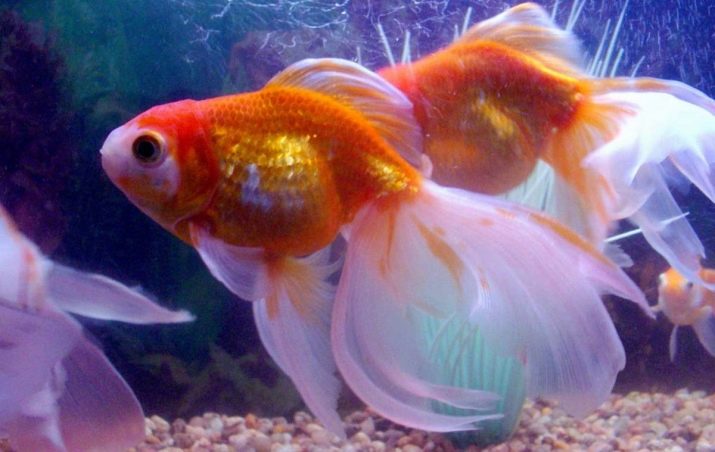
Despite such a large list, the scalar can be placed together with very small fish and even live-bearers. Aquatic neighbors for cichlids can be thorns, swordtails, zebrafish, small catfish, pelvic parrots, apistograms, gurus, lalius. Remember that Angel fish are those fish that live long (10 years). They are easy to maintain, but it is advisable not to start them for beginners. Inexperienced fish farmers often incorrectly calculate volumes and stable water parameters, which can lead to the death of fish.
There are no problems with feeding. They eat all kinds of food. The basis of the diet can be flakes (only high-quality), live and frozen food (tubifex, bloodworms, cortetra, brine shrimp). The scalars are beggars, they eat without measure, do not give them a lot of food. Feed the bloodworms with care. Otherwise, you will get bloating and even death. Soft plants can also serve as food for cichlids. To protect them from scalars, add spirulina food to your fish's diet.

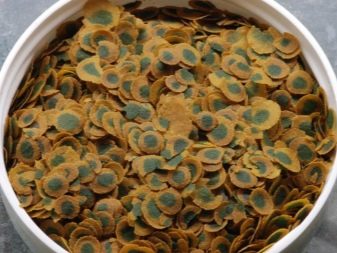
They are only kept in aquariums with high rims (120 liter capacity) due to their specific structure. If there are several individuals, you will need a container of 250 liters or more. Scalarians love warm water (+ 25– + 27 ° С). Natural habitat guarantees them a slightly acidic environment, but now the scalars adapt well to other conditions. Avoid sharp-edged decorations in the aquarium (cichlids will get hurt). But do not put moss there, they will still eat it, plants with large leaves (Amazon, nymphea) are better suited.
Filter the water and put the filter (an external filter is better) on a moderate mode, since the abundant flow of water can cause panic in scalars, which will affect the health and well-being of fish (they spend a lot of energy from nerves, nutrients are consumed faster and "fly away into the pipe ", That is, do not benefit). Change the water daily by about 20% of the total. Cichlids do not like harmful substances that accumulate in water. The scalars prefer clean water. This condition is relevant especially when young growth appears in the container.
It is impossible to recognize a female or a male in cichlids until full maturity comes. And this can only happen when the female begins to spawn. In other cases, you can be wrong, despite the external differences.
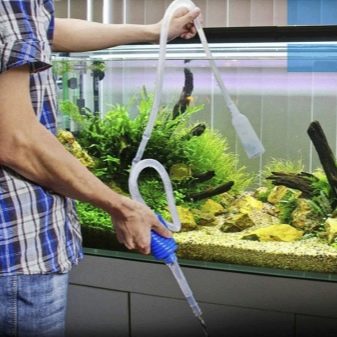
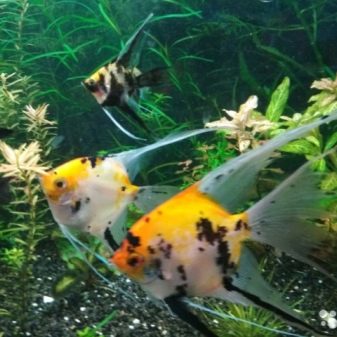
What is caviar?
Cichlids live in pairs and are usually monogamous. Scalarians can spawn in an aquarium (where there are other fish), but their safety is not guaranteed. Usually angelfish eggs are placed vertically. It can be non-sharp fragments of pipes, plexiglass (even the wall of the aquarium), a piece of driftwood, and so on.
Cichlids are caring parents. They protect the caviar. When the youngsters hatch, the female and the male are close, after hatching, courtship continues until the fry start swimming. Pisces angels always choose their partner with great interest. That's why it is necessary to acquire young fish so that you get an even number... And only then they will determine who will stay with whom.
Before the start of spawning, the breeding pair of scalars chooses a cozy place for themselves and drives away other fish that are nearby. It usually turns out that all the inhabitants of the body of water accumulate in one corner, and a couple with caviar in another.
By the way, scalars often destroy their eggs, this happens due to a negative situation. It is necessary to provide angel fish during spawning with peace of mind for their offspring, then this problem will disappear.
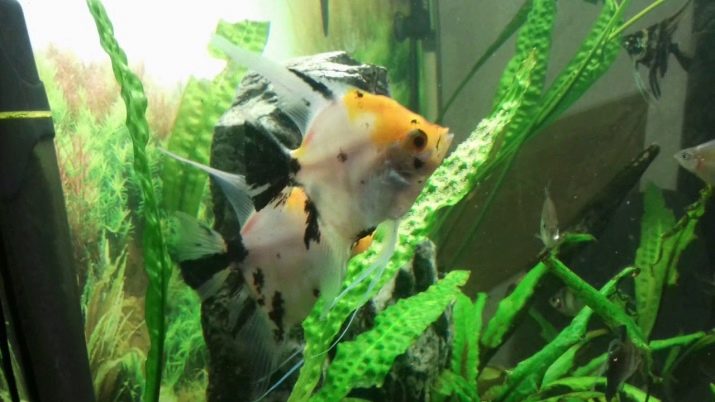
Cichlids reach sexual maturity at about a year. From then on, they can start spawning. It can happen every 7-10 days if you start taking it out. As a matter of fact, spawning occurs as follows: the female places eggs in a whole chain (several hundred). A male swims next and fertilizes them.
The caviar of angel fish is large and light. Scalarians fan them with fins to protect them from harmful accumulations. Unfertilized and dead eggs are eaten. Several days pass, the eggs begin to hatch. The larvae are also attached to the surface and feed on the contents of the so-called yolk sac.
Then another week - and the larvae turn into full-fledged fry, after which they begin to swim. Then self-feeding begins. They consume young feed or Artemia nauplii (the best choice). Portions of feed should be eaten by young animals in 3 minutes... Feeding is done four times a day. The container where the fry are located should be equipped with a filter with a sponge and without a lid (so that the fry is not sucked in), the power should be medium.
You need to change the water every day by 50% so that there is no mass death of fry.
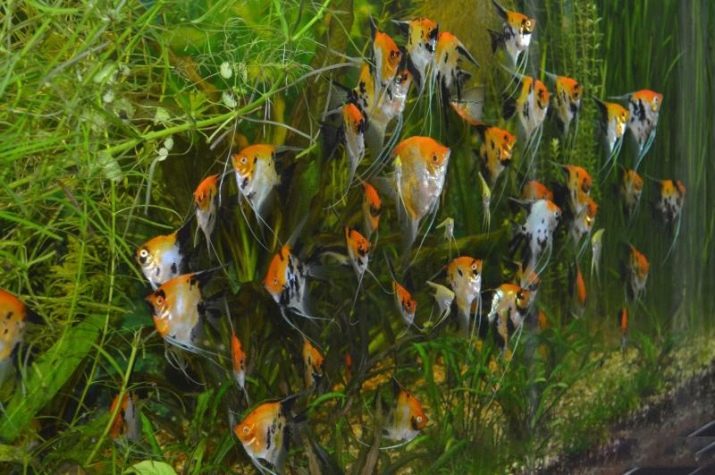
For more information about the features of these fish, see the next video.








